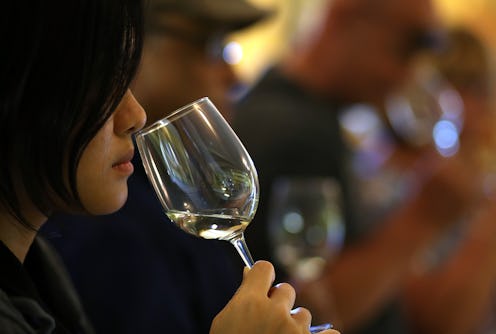Life
The 10 Best Places For Wine Lovers
Is wine the most adult drink? Like art or sex, best appreciated once a requisite number of years have passed? Should Trader Joe's be allowed to sell bottles of wine for three dollars? Isn't drinking wine and going on wine tours about more than getting boozy? Isn't a deeply personal, possibly even spiritual, experience?
In the age of artisan everything, it can be tempting to lose sight of wine, which was artisan to begin with. After all, the stock image of the wine-taster swirling a gulp around his mouth and throwing out what sound like answers to a food-themed crossword — pine nuts! bleu cheese! turnips! beef! — has been around for years.
Maybe the best way to experience wine, though, isn't to resort to same old artisan methods of appreciation. Maybe attending a wine-tasting glass or uploading pictures of full glasses to Instagram won't get you any closer to the truth of that miraculous, perilous drink. Maybe, what sets wine apart from other foods and drinks is that it demands, for a full immersion in its history and subtleties, a visit to the source.
Wine tourism may sound like a first-world affectation, but few drinking-based adventures are as enriching. A side benefit: it turns out that grapes like to grow in some of the most beautiful cities right here in America. Here are the best cities and regions to visit if you love wine.
Finger Lakes, New York
The Finger Lakes region of New York is a nature lover’s paradise, with its waterfalls, steep peaks, hiking, and camping. It’s also a mecca for winos. The area specializes in Riesling, a white wine made from sweet grapes. While it’s hard to pin down a specific city that stands above the rest (the Finger Lakes is truly a region you need to roam to experience), the area’s website should help you navigate this burgeoning wine scene.
Snake River Valley, Idaho
Located near Boise (and, more importantly for nature lovers, near Boise National Forest), this high-altitude region of Idaho has been pushing out wines that have earned it comparisons to Spain’s Rioja region. Reislings, Syrahs, and Bordeauxs are among the must-samples for any visitors to this up-and-coming and gobsmackingly beautiful region.
Charlottesville, Virginia
In addition to his other eccentricities, Thomas Jefferson holds the distinction of being one of the first Americans to try his hand at winemaking. To this day, Charlottesville, which Jefferson called home, carries that torch. Near his famous homestead, called Monticello, are some of the state’s leading wineries, all of them located on the tribute-paying Monticello Wine Trail.
Sonoma County, California
Napa, Shnapa. Sonoma Valley in California, while proximal to that other show-stealer, differs in its ethos. As one wine blogger puts it, “Napa Valley is Wine Disneyland, while Sonoma Valley is a wine region.” More specifically: “The winemaking and grapegrowing work in Napa is done with an eye equally trained on appealing to visitors. Sonoma Valley’s winemaking and grapegrowing is done only a wink at tourism.”
Consider it a Brooklyn to the Manhattan of wine tourism. While visitors to the area’s wineries will find that just about every type of wine imaginable abounds in this region, Zinfandel is a must-try California classic.
Louisville, Kentucky
Kentucky calls to mind bourbon, and many of the wines from the state — which was actually home to the first commercial vineyard in the country — might as well: Many Kentucky wines are made in bourbon barrels, which lends them a distinctive flavor. Before you visit, though, keep in mind: liquor before wine, you’re fine. (The other way around, not so much.)
San Antonio, Texas
Along with Austin, San Antonio sits at the center of what’s known as Texas “Hill Country.” This region is home to a large portion of the state’s 200-plus wineries, and its vineyards specialize in warm-weather wines, such as Italian Sangiovese and French Syrah.
Walla Walla, Washington
“Walla walla” might sound like a hungover person’s parched approximation of “water, water” but it’s in fact an all-the-rage wine city in Washington state. Located in a county of the same name on the eastern side of the state, south of Spokane, the city is home to some 125 wineries, as well as a spate of downtown tasting rooms.
Grand Junction, Colorado
That Grand Junction in Colorado is a certifiable wine destination speaks to the diversity of environments in which wine grapes can be cultivated. According to USA Today, the “high desert country of western Colorado has a microclimate perfect for vineyards.” Visitors can even ride a wine-tasting train from Denver. If you decide to hop on, be sure to sample the region’s biggest billings, Riesling and Cabernet Franc.
Traverse City, Michigan
This city in northern Michigan was once known as the cherry capital of the world, and the climate that proved ideal for that fruit is now being harnessed for exciting new wines. As IB Times points out, Traverse City is situated at the same latitude as Bordeaux and Burgundy in France. And while Michigan doesn’t have quite the claim on romance and history that France does, visitors will doubtless enjoy the area’s natural beauty —views of the Grand Traverse Bay abound — as they uncork its array of reds and whites.
North Fork, Long Island, New York
The north fork of Long Island doesn’t get the attention that the south fork, but this is probably a good thing: The area’s low-key atmosphere has given rise to a thriving wine culture: the region sports some 60 vineyards and 30 wineries. Wine tours from the city allow visitors to taste the area’s array of wines (and to get a breath of fresh air).
Images: rockinredblog; lambdagirl; photolohre; monticellowinetrail; tncmom; dan_at_mama_ps_wholesome_grind; kmcsoon; melissaincolorado; stefhawl23; jackie_dazzo;
